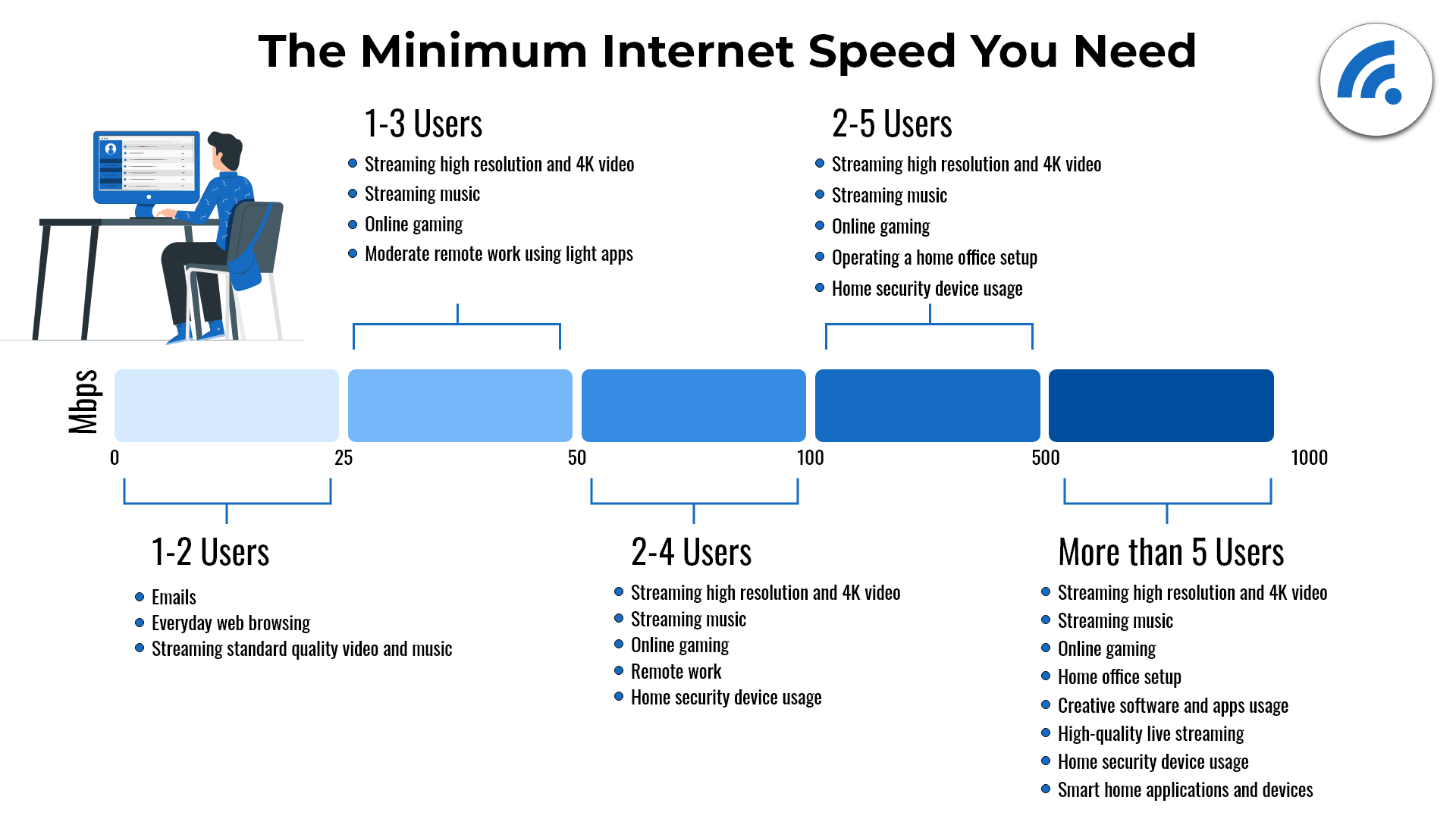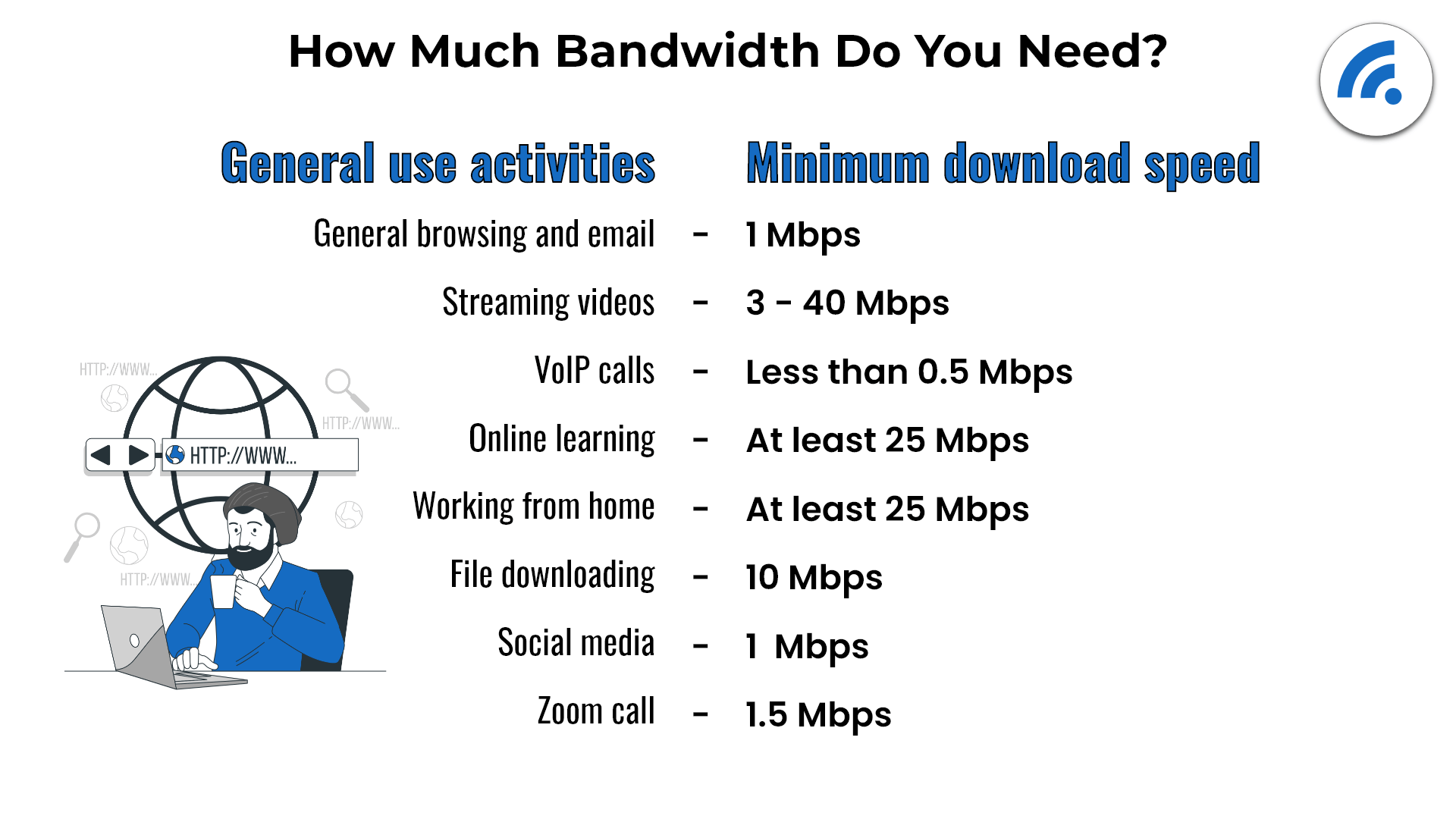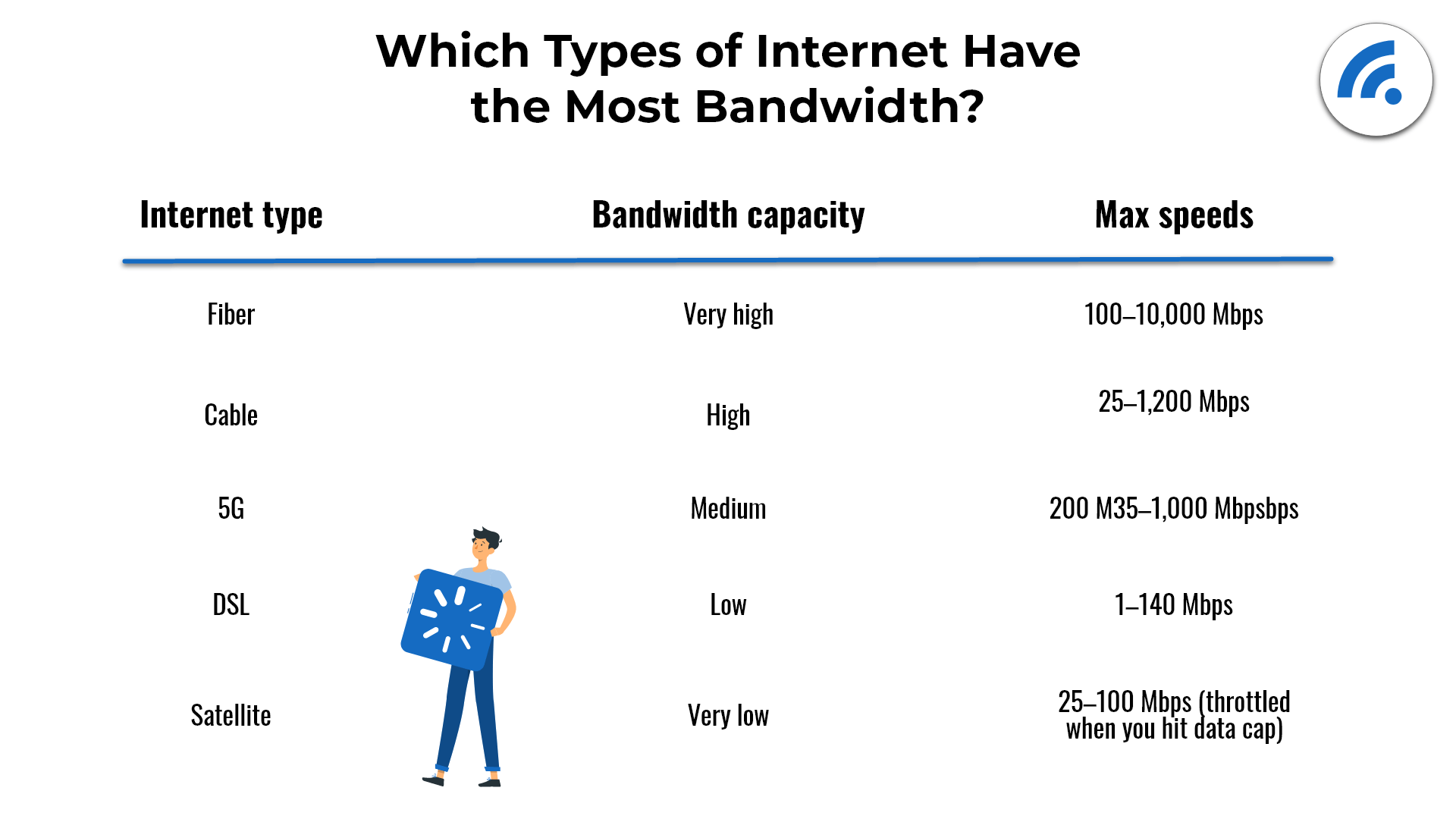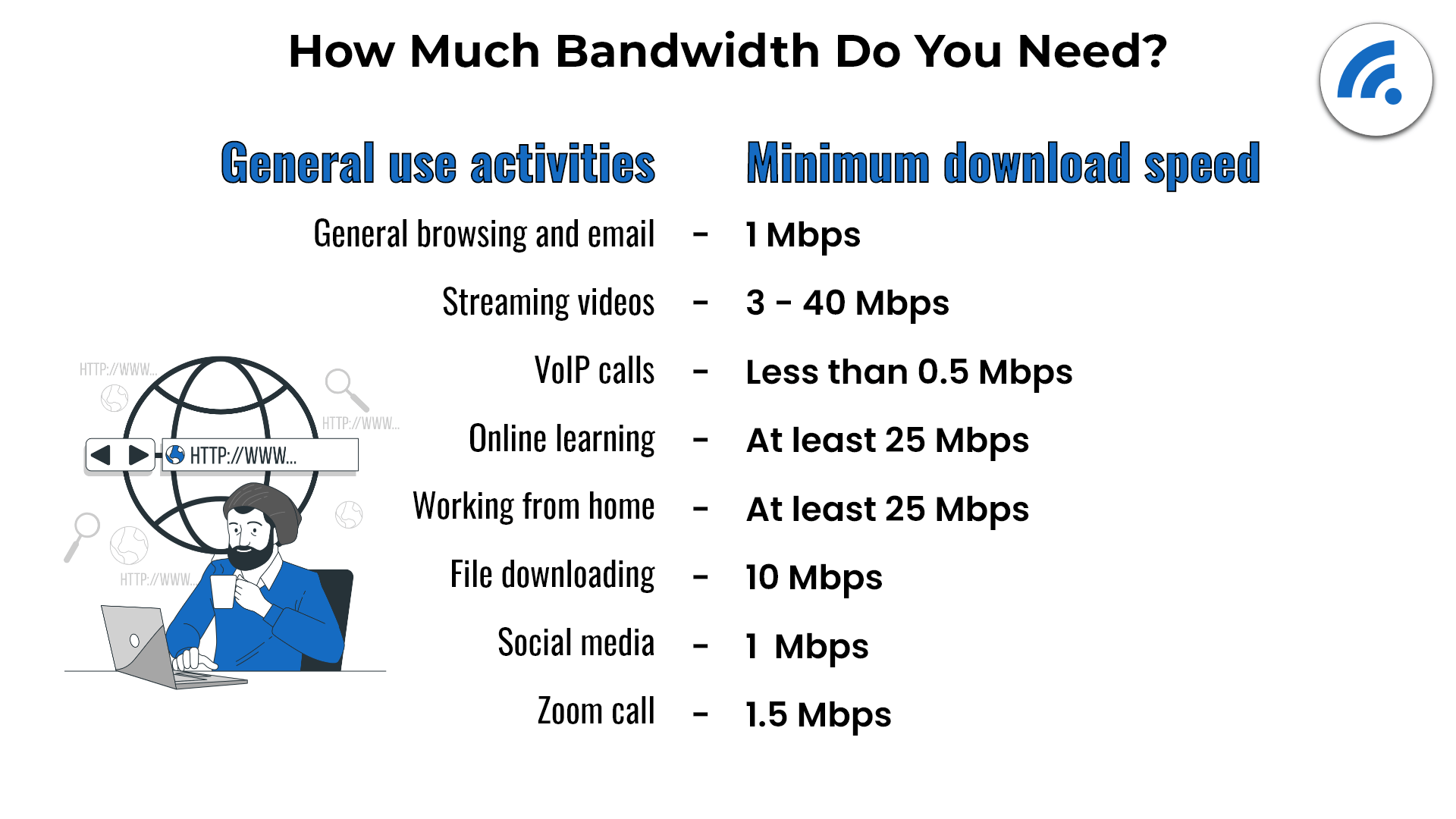The internet is more prominent now than it’s ever been and it’s not going anywhere anytime soon. Everyone wants fast, high-quality internet. But it’s a difficult concept to grasp with words like bandwidth, latency, download, and byte being thrown around.
Luckily, that’s about to change.
Bandwidth vs Internet Speed: The Differences Explained
The difference between bandwidth and internet speed should be noted–and it’s really quite simple. Though related, bandwidth is not the same as speed. In short, bandwidth refers to how much data can be uploaded or downloaded from our device, and internet speed determines how fast this process happens.
Here’s an illustration that will be mentioned a few times: Bandwidth is like a highway and the cars are the data. There can never be more speed than bandwidth. Or let’s say you want to download a video that is 10 Mb in size and you only have 1 Mbps of bandwidth. This video will take 10 seconds to download.
But if you have 10 Mbps of bandwidth? The video will only take one second. To give you a better idea: Both bandwidth and speed are measured in Mbps. High-speed internet is classified as between 50 and 100 Mbps.
Internet Speed: The Terms You Should Know
Now it’s time to get technical. The terminology can be complex and some words are used interchangeably that shouldn’t be. To fully understand all the factors that go into internet speed, there are some terms that you should know:
- Bandwidth is often mistaken for internet speed but the two differ. Bandwidth is a high-speed data transmission that transfers data from one location to another. Additionally, bandwidth is measured in Mbps.
- The term broadband refers to the transmission of bandwidth over a high-speed internet connection. According to the Federal Communications Commission (FCC), broadband internet requires a minimum of 25 Mbps download and 3 Mbps upload speeds.
- A bit is fairly straightforward: it is the smallest unit of data that a computer can process. A byte is in the same family as a bit and is equally as simple. It is a unit of data that consists of eight bits.
- Download and upload are also familial. A download is where your device receives data, such as a photo or video. An upload is the opposite– your device sends data somewhere else–such as posting a photo on Instagram.
- Latency refers to how much time it takes for data to travel from point A to point B. A number as close to zero is ideal. High latency is synonymous with buffering.
- Mbps is shorthand for “megabits per second.” In short, Mbps is a measurement of broadband, bandwidth, and internet speed.
- Modem is short for “Modulator-Demodulator.” A modem allows your device to connect to the internet. If you unplug the modem, for example, you won’t be able to connect to Wi-Fi. A router, on the other hand, allows all of your devices (wired and wireless) to connect to the internet source.
- Ping time is measured in milliseconds and is similar to latency. A ping is the amount of time it takes data to travel one way. Latency is the time it takes data to make a round trip.
Internet Speed & Bandwidth Explained
Internet speed and bandwidth are interconnected but are not synonymous. They both are, however, measured in Mbps and essential to ensuring you receive the best internet quality. Additionally, they both play a vital role in determining what you can do online.
Like the aforementioned highway, the more traffic you have the more bandwidth is needed. This is why the quality of your Zoom conference diminishes the second your kids hop online.
What you want to do online will determine what bandwidth you need. The more you want to do–and the more users that will be on the network–the more bandwidth you will need.
Internet Speed In Depth
Fast internet speed is what we all want. No one likes to be in the middle of a Netflix binge and, all of a sudden, season five of Breaking Bad won’t load.
There are many factors contingent on having high internet speed. Streaming services, downloading, uploading, casual internet browsing, and meetings over Zoom rely on quality internet speed.
This, of course, comes with many advantages.
Advantages of Higher Internet Speed
It’s not difficult to think of the numerous benefits that come with high internet speed. Elaborating on every single one would mean this article would never end. Here are a few:
- Boost Productivity
- Better Communication
- Improved Mental Health
If you’re constantly waiting on a web page to load, it’s no secret that you won’t get as much done. Higher internet speed correlates to increased productivity.
As with enhanced productivity, better communication is another benefit of quality internet speed. In a remote world, where Zoom and Slack reign supreme, you need to stay up to date with what your co-workers are saying. It’s difficult to achieve this if your screen is buffering and the meeting started 10 minutes ago.
Constantly waiting and worrying if you’re going to meet the next deadline is stressful. Higher internet speed takes some of that weight off your shoulders–resulting in improved mental health.
Disadvantages of Lower Internet Speed
We’ve all been there. Zoom kicks you out due to an unstable connection. Now you have to go to the coffee shop down the street to have secure Wi-Fi.
Less-than-ideal internet speed comes with many disadvantages for you or your business. Video conferences lag, your apps work slower than they need to and you become frustrated with life.
Bandwidth 101
Here’s an illustration: you’re driving down Highway 1 and get stuck in traffic. Bandwidth is the highway and cars are the data.
When there’s not a traffic jam, your internet is fine and running smoothly. However, if you’re on a conference call and your kids start playing Call of Duty, your internet quality diminishes.
Another way to look at it is water running through a pipe. To increase the speed of the water, you need a bigger pipe–you need to increase the bandwidth.
Advantages of Higher Bandwidth
It doesn’t matter whether you’re curious about bandwidth for personal or business reasons–higher bandwidth enables you to get the most out of your internet provider. As with higher internet speed, a larger bandwidth comes with many advantages. Collaboration is easier, crashes are rarer and websites function better.
Disadvantages of Lower Bandwidth
Having lower bandwidth is likely to be a disaster. In layman’s terms, low bandwidth means slow internet performance.
Back to the highway illustration: a single car can zoom down the freeway like it’s the Autobahn. A single network request can do the same. But the more traffic–the more network requests–and the pace slows.
How Much Internet Speed and Bandwidth Do You Need?
Determining how much internet speed and bandwidth you need is one small factor in creating a hassle-free life. Think of all the time that’s saved when things are running smoothly.
Internet Speed: How Much is Needed?
Measuring your internet speed is of the utmost importance. In a sense, it determines everything you can ad can’t do online. Additionally, this decides how many devices can be connected at once.
Internet speeds are generally broken into four ranges. They are:
- 5-40 Mbps
- 40-100 Mbps
- 100-500 Mbps
- 500-1,000 Mbps
Naturally, the speed needed is specific to each person. It’s not one size fits all. But it matters concerning what you want out of your internet–be that work, streaming services, or social media. The number of devices you have should also be taken into account.

In terms of streaming services, opt for around 100 Mbps. But for those with the “go big or go home” motto, 200-500 Mbps would cover most families where multiple devices may be watching something different at the same time.
A minimum download speed of 50 Mbps download speeds should enable you to work from home without interruptions. A quality Zoom session only requires 25 Mbps. Social media requires the lowest speed. You can successfully scour Instagram and Facebook with as little as 3 Mbps, however, at least 10 Mbps is recommended.
This leads to two questions: What is an internet speed test and how can I test it?
According to Gartner.com, an “internet speed test (also known as a broadband speed test) is a measure of the rate at which data is downloaded and uploaded.” In short, it measures how fast your device can download and upload data.
Running an internet speed test is important for many reasons. It will let you know what your internet speed is and may keep you from upgrading if you don’t need to. Luckily, many sites will conduct a speed test for free.
Significance of Measuring Bandwidth
Measuring bandwidth is equally important. Bandwidth, essentially, is the volume of data that can be sent from one connection to another. Bandwidth is calculated in terms of upload and download speed. Uploading is sending data to another source; downloading is receiving information.

Whatever your niche–streaming, gaming, or video calls–bandwidth calculators can help you determine how much bandwidth you need. Measuring bandwidth is just as easy as conducting an internet speed test via a bandwidth calculator. Here, upload and download times can be estimated.
Other Factors that Affect Internet Speed
Despite the importance of internet speed and bandwidth, other factors affect the speed of your internet. Among them is your type of internet connection, the speed of your devices, location, internet usage, and your internet plan.
Different Types of Internet Connections
If you were born before 2000, you probably remember the dial-up hassle. That is still a type of internet connection, however, we have moved on to quicker innovations. The type of connection for you is specific to your needs and they are as follows:

Fiber
First on the list is the fiber internet connection. Fiber relies on light to process information rather than electricity. It comes with many benefits such as being faster, better gameplay, and the ability to connect multiple devices without sacrificing speed. The main disadvantage is light propagation–data can only travel one way.
Cable
This connection is also popular–it’s the one that comes with the ethernet cable. The advantages of the cable connection include better overall speeds, lower latency, and enhanced security. Mobility, setting up and installation fees are the most notable cons.
DSL
Digital subscriber line (DSL) is a connection type that works through a phone line. Perhaps the best benefit is how inexpensive it is. Additionally, DSL connections are more secure and fast for downloads. The downside is that you will have to have phone service, service may come with a data cap and your internet speed is contingent on your proximity to a DSL location.
Fixed Wireless
Fixed wireless internet is a reliable, high-speed internet connection serving those in rural areas. A few upsides to this are no cable or phone service is required, the connection is reliable and there are no data limits. Location is a major disadvantage–not all locations will be within range of a tower. Additionally, the fixed wireless option is often more expensive than a DSL connection.
Satellite
With this type of connection, an internet signal is retrieved from a satellite–literally one orbiting the Earth. Satellite internet is a work in progress but it’s developing at a fast pace. This type can be done yourself and is much faster than dial-up. However, it comes with high latency and is slower than cable and fiber connections.
Dial-up
This is a classic. The dial-up internet connection uses the public switched telephone network to connect to the internet. Dial-up is available to anyone with a phone line and is a choice for those in areas that fixed wireless won’t reach. It also is easy to set up and affordable. Two fallbacks are that you can’t use the phone while on the internet and it is slow. Very slow.
The Speed of Your Devices
Your device is another factor that determines the speed of your internet. Generally speaking, newer devices come with newer processors–enabling them to send and receive data at a faster rate. Older devices don’t have this luxury. Additionally, having an older device connected to your internet can slow down all the devices on that network.
The Number of Users
This is where the highway and your available bandwidth come in. When you have multiple devices connected to the network, the bandwidth must be divided and shared. So a low bandwidth with the whole family connected to the network may result in slow speed.
Location
In layman’s terms, internet speed can be faster or slower depending on your proximity to the router. But there’s more to it than that. Where you live matters.
If you live in an area where fiber or cable connections are offered, then you have the luxury of having faster speeds. However, if you live in a rural area, you may only have the option of going with DSL.
There’s nothing wrong with a DSL connection. But it is here that location proves vital. Being closer to the network centralizer will bring your faster speeds.
Internet Usage and Utilization
Internet usage and utilization also contribute to the speed of your internet. Usage refers to the amount of data that is being transferred from one place to another.
There are many factors that go into data usage: uploading, downloading, surfing the web, and streaming. These all contain data, however, more important, is the application you use to do these things.
Your different activities will have different usage amounts. For example, downloading a movie will take significantly longer than uploading a single photo.
Your Internet Plan
If you live in a single household and you have the newest MacBook, then your internet plan could be the root of your problem–you may not have enough bandwidth.
As stated, the FCC says that 25 Mbps is high-speed internet. Having only 10 Mbps could be the reason Netflix is slacking.
Best Internet Plans for Speed and Bandwidth
The good news is that providers such as Xfinity, Spectrum, Verizon, Google, and AT&T are innovating and coming out with faster, more reliable internet services. Implementing higher bandwidth makes it easy to find the service that fits you.
Xfinity Connect
This service starts at $30 per month and comes with 75 Mbps. This service can be upgraded to Connect More for $40 per month and 200 Mbps. If you still don’t like the sound of that, they have a Superfast option that is $70 a month and comes with 800 Mbps.
Spectrum Internet
Spectrum also gives you options. Starting with the basic plan, you can receive up to 300 Mbps for 12 months at $49.99 per month. Those with a family of four may be interested in Spectrum’s Ultra plan which gives up to 500 Mbps at a rate of $69.99 a month.
Verizon Internet 200/200
Verizon’s Fios Internet 200/200 comes with, you guessed it, 200 Mbps for $49.99 monthly. This is a 100% fiber optic network. They also have bandwidth options of 400 Mbps ($69.99/mo), 940 Mbps ($89.99/mo), and up to 2,048 Mbps (119.99/mo).
Additionally, Verizon offers 5G internet of 300 Mbps ($50/mo) and 1,000 Mbps ($70/mo).
Google Fiber
Google Fiber offers 1 and 2 Gig internet plans. Starting at $70 a month, the 1 Gig plan offers 1,000 Mbps upload and download speeds. At $100 per month, you can double the download speed with 2,000 Mbps and still have 1,000 Mbps upload speeds.
AT&T Internet 5000
AT&T’s Internet 5000 may be the most expensive on the list but it’s also the fastest. For $190 per month, you can enjoy download speeds of up to 5 Gbps. As with the others, AT&T also offers cheaper options.
If you’re tired and frustrated with your current internet speed, it doesn’t have to be that way. It doesn’t take long to make a change.
And That’s a Wrap
We’ve covered a lot of ground here so it’s only natural for an in-a-nutshell recap. Whatever your interest–online gaming, remote work, or Netflix binges–it’s essential to have quality internet that gives you no problems.
Every facet matters: your device, location, number of users on the network, internet plan, and connection. These parts, though small in and of themselves, make up the whole that gives you the optimal internet speed.
FAQ
What type of internet is the fastest?
Reaching download speeds of 2,000 Mbps and upload speeds of 1,000 Mbps, fiber internet is a newer technology that ranks the fastest.
What type of internet speed is the best for business?
It’s recommended that most businesses should have at least 25 Mbps download speed and 3 Mbps upload speed. This is the average business. Naturally, the larger the business, it would be ideal to increase those numbers.
What is the difference between bandwidth and latency?
Terminology like bandwidth and latency can be confusing. Bandwidth is the total amount of data and latency is how fast the data travels.
What’s an acceptable ping for online gaming?
20ms to 50ms is acceptable, however, less than 20ms is desired for the best gaming experience.
What is a good download and upload speed?
A download speed of 100 Mbps and an upload speed of 10 Mbps is suffienct for everyday online use. This enables you to watch Netflix, conduct Zoom meetings and play onling games.

